Warmer weather is approaching! Many of us are excitedly packing away our winter clothes and anticipating sunny days enjoyed outside. But if our pneumatic systems could talk, they would not share our enthusiasm for spring and summer. Because as temperatures rise, so does the likelihood of moisture working its way through them. But is this a problem? And if it is, how can it be avoided? Keep reading to get the answer to these questions (and more) as we cover why water forms in airlines, the problems it causes, and how to get rid of the unwanted moisture.
Jump to a section:
The cause of moisture in air lines
Why moisture must be removed from air lines
Best practices to prevent moisture buildup
Cost-effective products to remove moisture from air lines
The cause of moisture in air lines
Increase in temperature
One of the most prominent triggers for excess water in pneumatic air lines is temperature increases. As temperatures rise, water evaporates and humidifies the air that your pneumatics rely on. People often say that the problem isn't the heat but the humidity, and that's as true for compressed air as it is for us. And remember, the air's humidity is only compounded when the air is compressed. Did you know that a 25-horsepower compressor can release more than 18 gallons of water in one day during the summer? That's potentially a lot of moisture in your system!
Rapid temperature changes
Another trigger is when the air temperature changes quickly. This can include temperature fluctuations in the ambient air of your operations or temperature changes within the system itself. For example, people often place air compressors outside or in a different (non-temperature controlled) room away from the rest of the system. During the warmer months, that compressor could deliver hot compressed air into cold air-conditioned indoor areas. That is a recipe for condensation as the warm, humidified air runs through cool, refrigerated pipes.
Why moisture MUST be removed
It's natural for water to be present in the air and fluctuate between its gas and liquid states. So why is even a small amount of water in your airlines so harmful? Simply put, it can put a significant dent in your wallet and bottom line. Here are a few of the most common issues that occur when excess moisture goes unchecked.
Loss of lubrication ➜ component failure
Pneumatic components are pre-lubricated at the factory, protecting them from premature wear and allowing them to function properly. Unfortunately, it does not take much water to compromise this lubrication, or even wash it away entirely. The rubber seals within these components are also prone to swelling, stiffening, and deterioration when subject to moisture. All of this leads to premature wear and the eventual failure of the components.
Bacterial growth
There is one thing that all bacteria and microorganisms need to thrive... moisture. When this is introduced, your pneumatic lines become breeding grounds for mold and bacteria. This accumulation will ultimately gunk up your system to reduce your airflow, as well as become a potential health and safety concern for those in contact with the system, or end product!
Pipe scale and rust
Moisture also causes pipe scale and rust to form. As rust builds in the system, it decreases the pipe's interior surface area, allowing less air to pass through and reducing the system's performance. Over time, the pipe scale and rust will detach from the piping and cause even more problems as they travel through the pneumatic system. The components within a pneumatic system are precise and intricate. When chunks of debris encounter the tiny inner workings and passageways, they become clogged rather quickly, resulting in poor performance and, ultimately, system failure.
Poor air quality for important processes
If compressed air is used directly in your product or processes, it's even more critical to remove moisture, and the byproducts moisture produces (bacteria, rust, and debris). Think about a paint booth or food processing plant, both of which relies heavily on compressed air. The rust and bacteria that make their way through the airlines will greatly decrease the paint's finishing qualities and cause health concerns for the food processing plant. Even places that use small blasts of air from blowguns to clean parts and products will not want to subject them to moist air carrying mold and rust.
Increased costs
Water in your compressed air lines can lead to unplanned work stoppages, possibly creating long downtimes to source, purchase, and replace the damaged components. At worst, portions of the final product will come into contact with the moisture and debris from the compressed air, causing latent damage and quality issues along with eventual system failure. All of these scenarios, unfortunately, lead to reduced profits.
Luckily, all of this doom and gloom can be avoided by following simple best practices.
Best Practices to prevent moisture in air lines
As we've learned, moisture in your compressed airlines can be a huge problem. So here are some of the best ways you can prevent moisture build-up in the first place.
Drain the air compressor
Air compressor tanks often contain a drain at the bottom so that collected water can be released. Make sure you are draining your air compressor regularly, especially during the warm months when it will accumulate faster. Remember, more demand will require more frequent draining.
Create consistent temperatures
Pay attention to differences in temperatures within your system. Remember that water vapors turn into liquid when passing from a warmer to a colder area, so design your pneumatic system to avoid such rapid temperature changes.
Choose proper system materials
Some metals, like steel, are prone to rust and pipe scale. Other materials, such as marine-grade aluminum pipes, are more rust-resistant and help prevent oxidation-based contamination. By implementing a piping system with cleaner interior surfaces, you decrease issues relating to moisture build-up and increase your system's airflow and integrity, so make sure to choose the best material to suit your needs.
Adjust pipe direction
Water vapor typically collects and pools at the bottom of the pipe as it condenses. One way to prevent this water from entering the rest of your system is to adjust where the other pipes connect to the mainline. By connecting these pipes at the top of the airline (instead of at the bottom where the water collects), you are more likely to provide dryer air into the rest of the system. This method will not eliminate water, but it will help minimize damages that could occur further down the line.
The best, cost-effective products to remove water in air lines
While the above practices to prevent moisture should be applied when possible, they may not be enough or cannot be applied to your system. In this case, there are numerous great products to help remove the excess water from your system.
All of these products are available on our website, airlinehyd.com.
Filters/regulators
Filter/regulators are essential components of pneumatic air lines that provide two critical functions:
1. Filtration: They filter the compressed air, removing dirt, dust, and moisture from the air to ensure that the air entering the system is clean and dry. This helps prevent damage to the pneumatic equipment, ensures reliable operation, and improves the system's lifespan.
2. Regulation: They regulate the pressure of the compressed air, maintaining a constant and consistent pressure level throughout the system. This helps prevent damage to the pneumatic equipment and ensures that the system operates efficiently and safely.
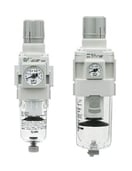 A great filter/regulator that reduces moisture and debris is the AW30 by SMC. This product works especially well if your system has high airflow, as the AW30 uses a cyclone effect to spin the air at high speeds. The cyclone effectively forces water and debris to the sides of the unit, where it becomes separated and drains out the bottom. This component requires a hefty amount of air pressure to function, so if that is lacking in your system, you may want to consider a different solution.
A great filter/regulator that reduces moisture and debris is the AW30 by SMC. This product works especially well if your system has high airflow, as the AW30 uses a cyclone effect to spin the air at high speeds. The cyclone effectively forces water and debris to the sides of the unit, where it becomes separated and drains out the bottom. This component requires a hefty amount of air pressure to function, so if that is lacking in your system, you may want to consider a different solution.
Water separators
Water separators, also called main-line filters, come in various sizes to remove water and other contaminants from the compressed air before it enters the main air line. They are typically installed at the beginning of the main air line, just after the compressor and before the regulator, to ensure that the air going into the system is clean, dry, and free of contaminants that could damage the equipment.
Water separators use a variety of filtration methods to remove moisture and contaminants from the compressed air, such as centrifugal force, coalescing filters, and adsorption filters. Some water separators also have automatic drain valves that periodically release the accumulated water and contaminants from the system.
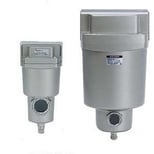
A great example is SMC's AMG water separator, which effectively removes 99% of the water from pneumatic lines. You can see it in action and how well it works in this demonstration video.
Shop "My Plant is Hot" products
Air dryers
Air dryers are another option for keeping water out of your pipes. Imagine you have a larger facility and are experiencing water throughout all of your airlines. This is where an air dryer would help, as they're designed for large water removal issues.
Air dryers are typically installed in larger pneumatic systems that require high-quality, clean, and dry compressed air. They help prevent damage to pneumatic equipment, ensure reliable operation, and improve the system's lifespan.
There are several types of air dryers, including refrigerated dryers, desiccant dryers, and membrane dryers.
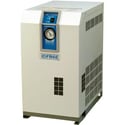 Refrigerated dryers can be thought of almost like a dehumidifier. As wet air comes into contact with the dryer, it is significantly cooled down, which turns the water vapor into actual liquid water. That water goes into a water trap. The cold air then goes through a process to heat back up to room temperature, resulting in dryer air. An excellent refrigerated air dryer to consider is SMC's IDFB refrigerated air dryer (pictured). These durable units have simple control systems and are easily serviced.
Refrigerated dryers can be thought of almost like a dehumidifier. As wet air comes into contact with the dryer, it is significantly cooled down, which turns the water vapor into actual liquid water. That water goes into a water trap. The cold air then goes through a process to heat back up to room temperature, resulting in dryer air. An excellent refrigerated air dryer to consider is SMC's IDFB refrigerated air dryer (pictured). These durable units have simple control systems and are easily serviced.
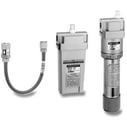 Membrane dryers are designed for convenient point-of-use drying without the need for electrical power. Membrane dryers utilize hollow fiber membranes to remove water vapor from compressed air. The drying power of the membrane is controlled by varying the compressed air flow rate and pressure. SMC offers the IDG, Membrane Air Dryer Series (pictured) that can combine a mist separator and micro mist separator with a single unit.
Membrane dryers are designed for convenient point-of-use drying without the need for electrical power. Membrane dryers utilize hollow fiber membranes to remove water vapor from compressed air. The drying power of the membrane is controlled by varying the compressed air flow rate and pressure. SMC offers the IDG, Membrane Air Dryer Series (pictured) that can combine a mist separator and micro mist separator with a single unit.
 Desiccant dryers use absorptive materials, such as silica gel, to absorb the water vapor within the lines. The vapor then turns to liquid and sticks to the contents until they are cleaned out. SMC's regenerative desiccant drying systems, the ID and IDW series (pictured), provide the greatest level of drying capability among widely available drying technologies.
Desiccant dryers use absorptive materials, such as silica gel, to absorb the water vapor within the lines. The vapor then turns to liquid and sticks to the contents until they are cleaned out. SMC's regenerative desiccant drying systems, the ID and IDW series (pictured), provide the greatest level of drying capability among widely available drying technologies.
With any air dryer, it's important to make sure the air pressure and capacity fit the compressor, and they also range anywhere from a few hundred dollars to several thousand, so make sure you do your homework or contact a professional before making a purchase.
Other temperature control products
The above-mentioned products are just a few examples of moisture and temperature control products. Airline offers a wide array of options you can shop online here. If you need additional help with your selection, contact our customer support, and our specialists will be happy to offer technical support.
Moisture in airlines causes major issues, ranging from component failure to unplanned downtime from system failure. By implementing these practices and cost-effective products, you can achieve clean and dry air during every season (even the hot and humid summer months). If you need help determining the most useful solution for your application, talk to an Airline expert. We can help you determine the best solution for your business's needs.

Additional Resources
- Water in Compressed Air Lines: Complete Troubleshooting Guide
- Learn About SMC
- SMC Product Configurator
- Shop Pneumatic Components
- More Pneumatic Blog Posts
- Contact Us
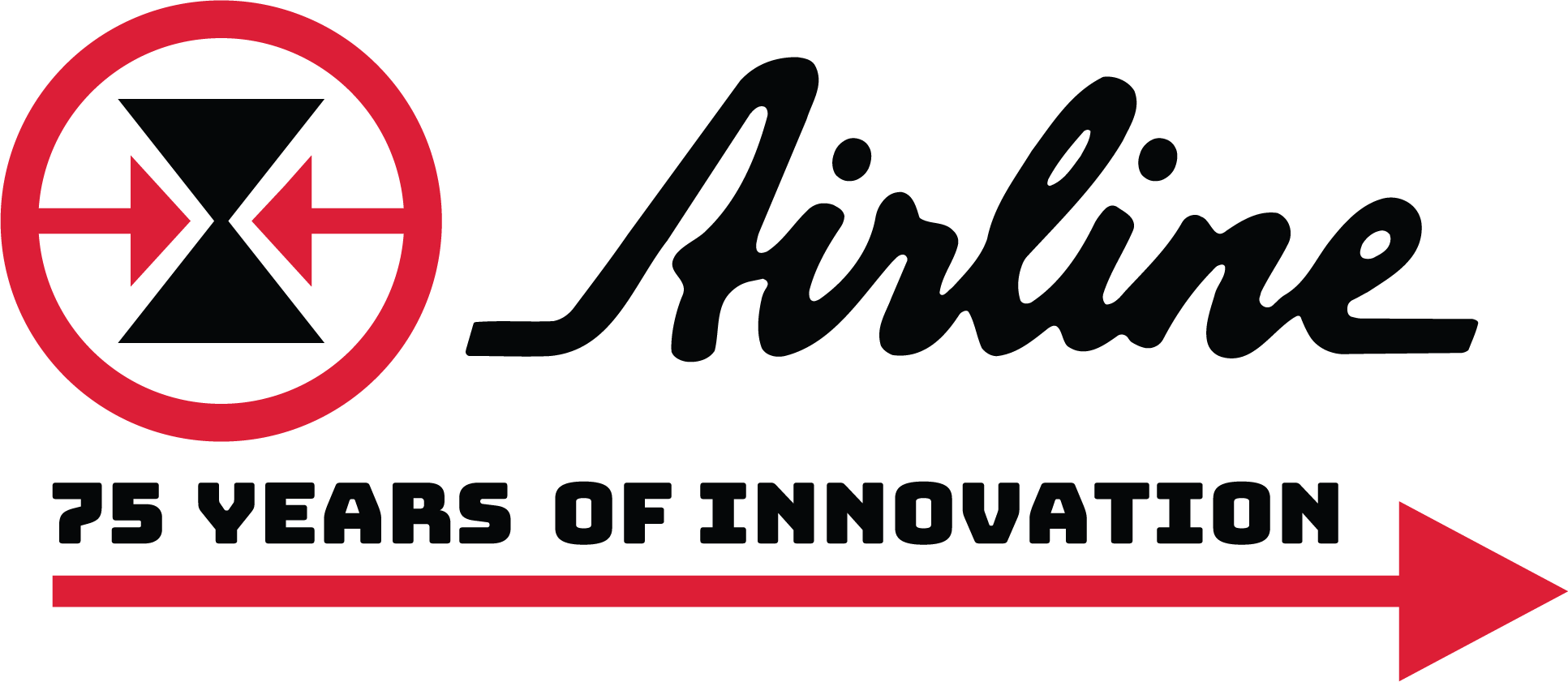












Leave Comment